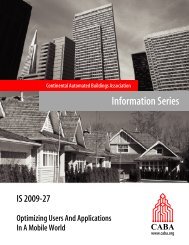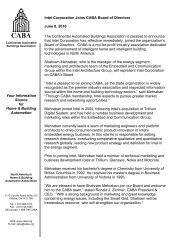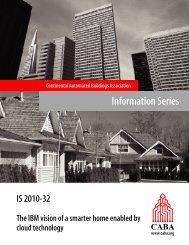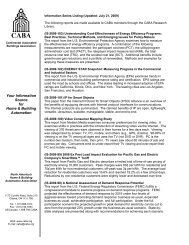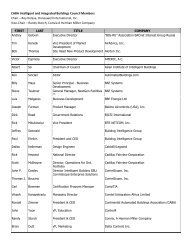Your Information Source for Home & Building Automation
Your Information Source for Home & Building Automation
Your Information Source for Home & Building Automation
You also want an ePaper? Increase the reach of your titles
YUMPU automatically turns print PDFs into web optimized ePapers that Google loves.
2<br />
(IS-2010-24) Federal Communications Commission: National Broadband Plan<br />
This report is a summary of decisions taken by the U.S. Federal Communications<br />
Commission in March 2010 regarding high speed Internet access using broadband<br />
communications. The FCC supports a policy of a competitive market <strong>for</strong> broadband with<br />
access to all especially deployment in high cost and low-income areas. The FCC is<br />
planning to support broadband with appropriate radio spectrum (extra 500 MHz within 10<br />
years) and rules to encourage competition <strong>for</strong> equipment such as set-top boxes. A goal<br />
of a minimum 4 Mpbs download speed is proposed with a desired service of at least 100<br />
Mbps. Possible applications of broadband by government agencies include healthcare,<br />
education, energy management (including real-time consumption data), economic<br />
growth, civic engagement, and public safety. Access rates of 1 Gbps are proposed <strong>for</strong><br />
public institutions in every community.<br />
(IS-2010-23) What global executives expect of in<strong>for</strong>mation security - in the middle<br />
of the world's worst economic downturn in thirty years<br />
This report from Price Waterhouse Coopers was written in 2009 to determine the effect of<br />
the recession on purchases of products to ensure data security. This survey of 7200<br />
persons found that expenditures would increase or stay the same. Investments in data<br />
security were considered worthwhile. Many were concerned that they did not know<br />
where their privacy-related data were stored. Also, social networking will challenge the<br />
requirements <strong>for</strong> data security.<br />
(IS-2010-22) AARA Survey Analysis<br />
This research brief from Pike Research examines consumer sentiment on energy and<br />
environment provisions within the American Recovery and Reinvestment Act of 2009.<br />
(IS-2010-21) Real Prospects <strong>for</strong> Energy Efficiency in the United States<br />
This executive summary from the National Academy of Sciences explores the impact of<br />
technology on improving energy efficiency. Potential savings by 2020 would come from<br />
buildings (53%), industry (35%), and transportation (12%). Some of the technologies that<br />
will impact buildings include LED lighting, new window systems, new cooling systems,<br />
and more efficient electronics.<br />
(IS-2010-20) BroadbandSuite 3.0 Companion Guide<br />
This article from the Broadband Forum provides an overview of specifications developed<br />
<strong>for</strong> telephone companies to deliver Internet access. The initial technology was DSL and<br />
now has moved to IP-Ethernet and fiber optics. The objective is to improve the delivery<br />
of IPTV and a better “Quality of Customer Experience” (QoE). Each specification is<br />
summarized. Future specifications will include IPv6 transition, converged network, and<br />
multi-service architecture.<br />
(IS-2010-19) Energy Management Systems <strong>for</strong> Commercial <strong>Building</strong>s<br />
This executive summary report from Pike Associates analyses the evolution of energy<br />
management <strong>for</strong> large buildings. Heating, cooling, and lighting account <strong>for</strong> 57% of<br />
building energy consumption. Energy expenditures <strong>for</strong> these functions were considered<br />
fixed costs. There is now a shift in thinking due to energy awareness, government policy,<br />
and applications of in<strong>for</strong>mation technology. Long term, building design will move toward<br />
net-zero buildings and electricity demand response. Shorter term, the focus will be on<br />
energy efficiency.<br />
(IS-2010-18) Green Telecom Networks<br />
This executive summary report from Pike Research examines the impact of green<br />
practices on the in<strong>for</strong>mation and communications and technology (ICT) industry. It<br />
focuses on plans by fixed and mobile telecommunications companies to reduce<br />
greenhouse gases. Although ICT accounts <strong>for</strong> only 2% of emissions, the industry is<br />
growing and may be able to reduce overall emissions by 15% over the next 10 years.<br />
Most approaches require higher initial investments. The industry is starting to evaluate<br />
life-cycle costs. Some of the approaches <strong>for</strong> reducing energy include equipment-cooling<br />
improvements, turning off unused equipment, use of renewal energy sources, and more<br />
efficient design of circuits <strong>for</strong> processors.



